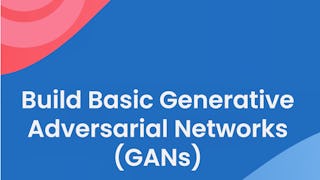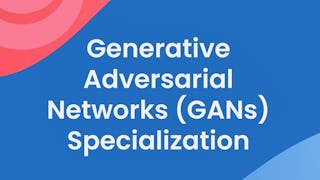This deep learning course provides a comprehensive introduction to Autoencoders, Variational Autoencoders (VAE), and Generative Adversarial Networks (GANs). Begin by exploring how autoencoders compress and reconstruct data, and discover how VAEs add probabilistic modeling to enhance generative capabilities. Learn the VAE training process and implement a VAE using TensorFlow for image generation with the MNIST dataset. Progress to mastering GANs—understand their adversarial training approach, how the generator and discriminator interact, and explore real-world applications. Gain hands-on experience by building a GAN to generate realistic fake images through step-by-step demos.



Introduction Course to Autoencoders, VAEs, and GANs
This course is part of Generative AI Models and Transformer Networks Certification Specialization

Instructor: Priyanka Mehta
Included with 
Recommended experience
What you'll learn
Build and train Autoencoders and VAEs using TensorFlow
Use VAEs for generating synthetic data like images
Understand and apply GAN architecture and training techniques
Create realistic outputs with GANs for real-world use cases
Skills you'll gain
Details to know

Add to your LinkedIn profile
June 2025
7 assignments
See how employees at top companies are mastering in-demand skills

Build your subject-matter expertise
- Learn new concepts from industry experts
- Gain a foundational understanding of a subject or tool
- Develop job-relevant skills with hands-on projects
- Earn a shareable career certificate

There are 2 modules in this course
Explore the fundamentals of Autoencoders and Variational Autoencoders (VAE) in this module. Learn how autoencoders compress and reconstruct data, the challenges they face, and how VAEs overcome them. Understand the VAE training process and its generative capabilities. Gain hands-on experience by implementing a VAE with TensorFlow for image generation using the MNIST dataset.
What's included
8 videos1 reading4 assignments
Master Generative Adversarial Networks (GANs) in this hands-on module. Learn how GANs work through their unique adversarial training process and explore real-world use cases across industries. Understand generator-discriminator dynamics and how they produce realistic data. Gain practical skills by implementing a GAN to generate fake images with guided demos and code examples.
What's included
4 videos3 assignments
Earn a career certificate
Add this credential to your LinkedIn profile, resume, or CV. Share it on social media and in your performance review.
Instructor

Offered by
Explore more from Machine Learning
 Status: Free Trial
Status: Free TrialDeepLearning.AI
 Status: Free Trial
Status: Free Trial Status: Free Trial
Status: Free Trial Status: Free Trial
Status: Free TrialDeepLearning.AI
Why people choose Coursera for their career





Open new doors with Coursera Plus
Unlimited access to 10,000+ world-class courses, hands-on projects, and job-ready certificate programs - all included in your subscription
Advance your career with an online degree
Earn a degree from world-class universities - 100% online
Join over 3,400 global companies that choose Coursera for Business
Upskill your employees to excel in the digital economy
Frequently asked questions
GANs (Generative Adversarial Networks) and VAEs (Variational Autoencoders) are generative models used to create new data samples. GANs use a generator-discriminator setup, while VAEs rely on probabilistic encoding and decoding.
GANs generate realistic data by pitting two networks against each other, while autoencoders compress and reconstruct data. Both are used in unsupervised learning but serve different purposes in data generation and feature learning.
Autoencoders are neural networks designed to learn efficient data representations by encoding input into a compressed form and then decoding it back to reconstruct the original input.
More questions
Financial aid available,

